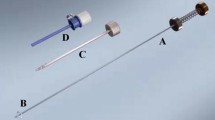Abstract
Electrosurgical energy may be utilized as an adjunct to mechanical force for insertion of laparoscopic trocars. The advantage of this approach may be better operator control of insertion, with less risk of intraperitoneal and retroperitoneal injury. To assess the safety and efficacy of electrosurgical trocars, we compared them to mechanical trocars in clinical and animal trials. During 100 trocar introductions in 25 laparoscopic cholecystectomies, insertion force was measured. In contrast to mechanical trocars, which required progressively more force to insert as size increased, electrosurgical trocars required the same low insertion force regardless of size. No wound complications occurred. In animal experiments, wound healing (measured histologically and by bursting strength) was normal and equivalent for mechanical and electrosurgical insertions.
We conclude that electrosurgical trocars require less force for insertion and do not impair wound healing. Electrosurgical trocars may thus offer important safety advantages over mechanical trocars.
Similar content being viewed by others
References
Baadsgaard SE, Bille S, Egeblad K (1989) Major vascular injury during gynecologic laparoscopy. Report of a case and review of published cases. Acta Obstet Gynecol Scand 68: 283–285
Chapron C, Querleu D, Mage G, Madelenat P, Dubuisson JB, Audebert A, Erny R, Bruhat MA (1992) Complications of gynecologic laparoscopy. Multicentric study of 7604 laparoscopies. J Gynecol Obst Bio Reprod 21: 207–213
Cunanan, RG, Courey, NG, Lippes J (1980) Complications of laparoscopic tubal sterilization. Obstet Gynecol 55: 501–506
Lightdale C (1987) Indications, contraindications and complications of laparoscopy. In: Sivak M (ed) Gastroenterologic endoscopy. WB Saunders. Philadelphia, pp, 1039–1044
National Institutes of Health (1985) Guide for the care and use of laboratory animals. NIH publication No. 85-23, rev ed, Bethesda, MD
Peterson HB, Greenspan JR, Ory WH (1982) Death after puncture of the aorta during laparoscopic sterilization. Am J Obstet Gynecolol 59: 133–134
Author information
Authors and Affiliations
Rights and permissions
About this article
Cite this article
Waxman, K., Birkett, D.H., Sackier, J.M. et al. Clinical and laboratory evaluation of an electrosurgical laparoscopic trocar. Surg Endosc 8, 1076–1079 (1994). https://doi.org/10.1007/BF00705723
Received:
Accepted:
Issue Date:
DOI: https://doi.org/10.1007/BF00705723




